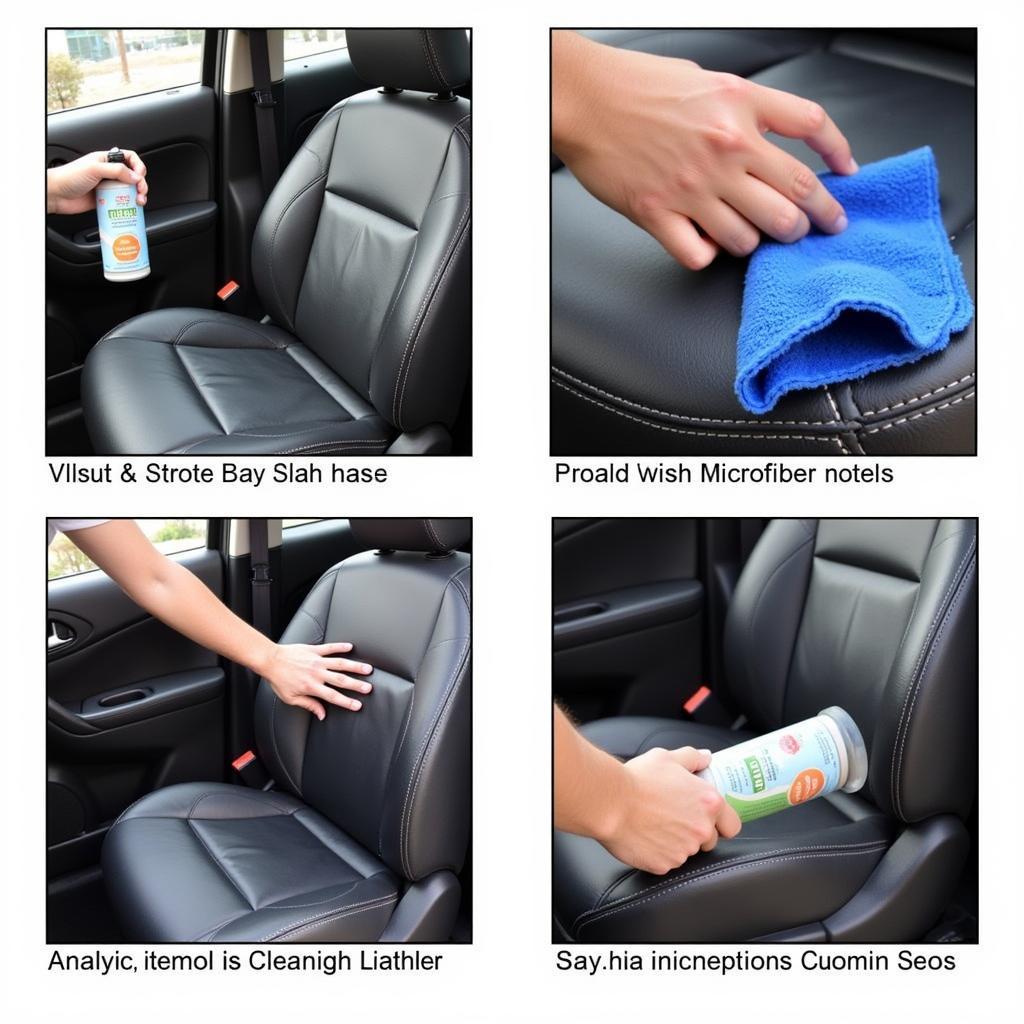Leather car seats exude luxury and comfort, but they can also be prone to various problems like cracking, fading, staining, and wear. Addressing these issues promptly is crucial to maintain the aesthetic appeal and value of your vehicle. This guide will delve into common problems with leather car seats and provide practical solutions for troubleshooting and repair.
If you’re experiencing a different car seat problem, check out our guide on general car seat problems.
Understanding Common Leather Car Seat Issues
Leather, being a natural material, is susceptible to damage from environmental factors and everyday use. Some of the most prevalent problems include:
- Cracking: This is often caused by dryness, excessive heat, and UV exposure. Cracks can appear as small surface lines or deep fissures, compromising the leather’s integrity.
- Fading: Prolonged sun exposure can bleach the leather, causing it to lose its vibrant color and appear dull.
- Staining: Spills from liquids, food, or even ink can leave unsightly marks on leather seats.
- Wear and Tear: Friction from regular use can cause the leather to wear thin, especially in high-contact areas like the driver’s seat bolster.
- Scratches: Sharp objects, pet claws, or even rough clothing can scratch the leather surface.
 Cracked Leather Car Seat Due to Sun Damage
Cracked Leather Car Seat Due to Sun Damage
Diagnosing Your Leather Car Seat Problem
Identifying the specific problem is the first step towards effective repair. Carefully inspect the affected areas for signs of cracking, fading, stains, or wear. Consider the location of the damage – is it on the seat surface, bolster, or stitching? This will help you determine the cause and choose the appropriate repair method.
Have you ever wondered if the color of your car is related to certain problems? Check out our article, does color associated with car problem, to find out!
DIY Solutions for Minor Leather Car Seat Problems
For minor issues like surface scratches or light stains, you can often employ DIY solutions:
- Cleaning: Use a dedicated leather cleaner and a soft microfiber cloth to remove dirt and grime. Avoid harsh chemicals or abrasive cleaners that can damage the leather.
- Conditioning: Leather conditioners replenish moisture and help prevent cracking. Apply a quality leather conditioner regularly, especially after cleaning.
- Stain Removal: For specific stains like ink or grease, use specialized leather stain removers. Always test the remover on a hidden area first to ensure it doesn’t damage the leather.
 Cleaning Leather Car Seat with Specialized Products
Cleaning Leather Car Seat with Specialized Products
When to Seek Professional Help
For extensive damage like deep cracks, tears, or severe fading, it’s best to consult a professional auto upholstery specialist. They have the expertise and tools to perform more complex repairs, such as leather patching, re-dyeing, or even seat replacement.
Preventing Future Leather Car Seat Problems
Prevention is always better than cure. Here are some tips to protect your leather car seats and prolong their lifespan:
- Regular Cleaning and Conditioning: This is the most important step in maintaining leather seats.
- UV Protection: Use sunshades or park in shaded areas to minimize sun exposure.
- Avoid Harsh Chemicals: Don’t use household cleaners or abrasive materials on leather.
- Use Seat Covers: Consider using seat covers, especially during long trips or if you have pets. You may have encountered carid seat cover problems; learning about them can help you choose the right cover.
 Applying Leather Conditioner to a Car Seat
Applying Leather Conditioner to a Car Seat
If you’re considering trading in a car with existing problems, you can learn more about the process in our article, trading in a car with engine problems.
Conclusion
Taking care of your leather car seats is an essential part of maintaining your vehicle’s appearance and value. By understanding the common problems with leather car seats and implementing the right preventive measures and repair techniques, you can ensure that your leather seats remain in top condition for years to come. If you have persistent problems with your car seats, don’t hesitate to reach out to us at AutoTipPro for expert advice and assistance. You can reach us at +1 (641) 206-8880 or visit our office at 500 N St Mary’s St, San Antonio, TX 78205, United States.
 Professional Leather Car Seat Repair
Professional Leather Car Seat Repair
Dealing with a different car seat issue? Our guide on car seat problem can help. Even for specific car models like the 1991 Lincoln Town Car, understanding common problems can be useful. Check out our resource on 1991 lincoln town car common problems.
FAQ
- How often should I clean my leather car seats? Ideally, every 2-3 months, or more frequently if they get dirty.
- What’s the best way to remove ink stains from leather car seats? Use a specialized leather ink remover and follow the manufacturer’s instructions.
- Can I use household cleaners on my leather car seats? No, avoid using household cleaners as they can damage the leather.
- How can I prevent my leather car seats from cracking? Regular cleaning and conditioning, along with UV protection, are crucial for preventing cracks.
- What should I do if my leather car seat is ripped? Consult a professional auto upholstery specialist for repair or replacement.
- How can I restore the color of faded leather car seats? A professional can re-dye faded leather seats to restore their original color.
- Are leather conditioners necessary? Yes, leather conditioners help keep the leather supple and prevent drying and cracking.






Leave a Reply